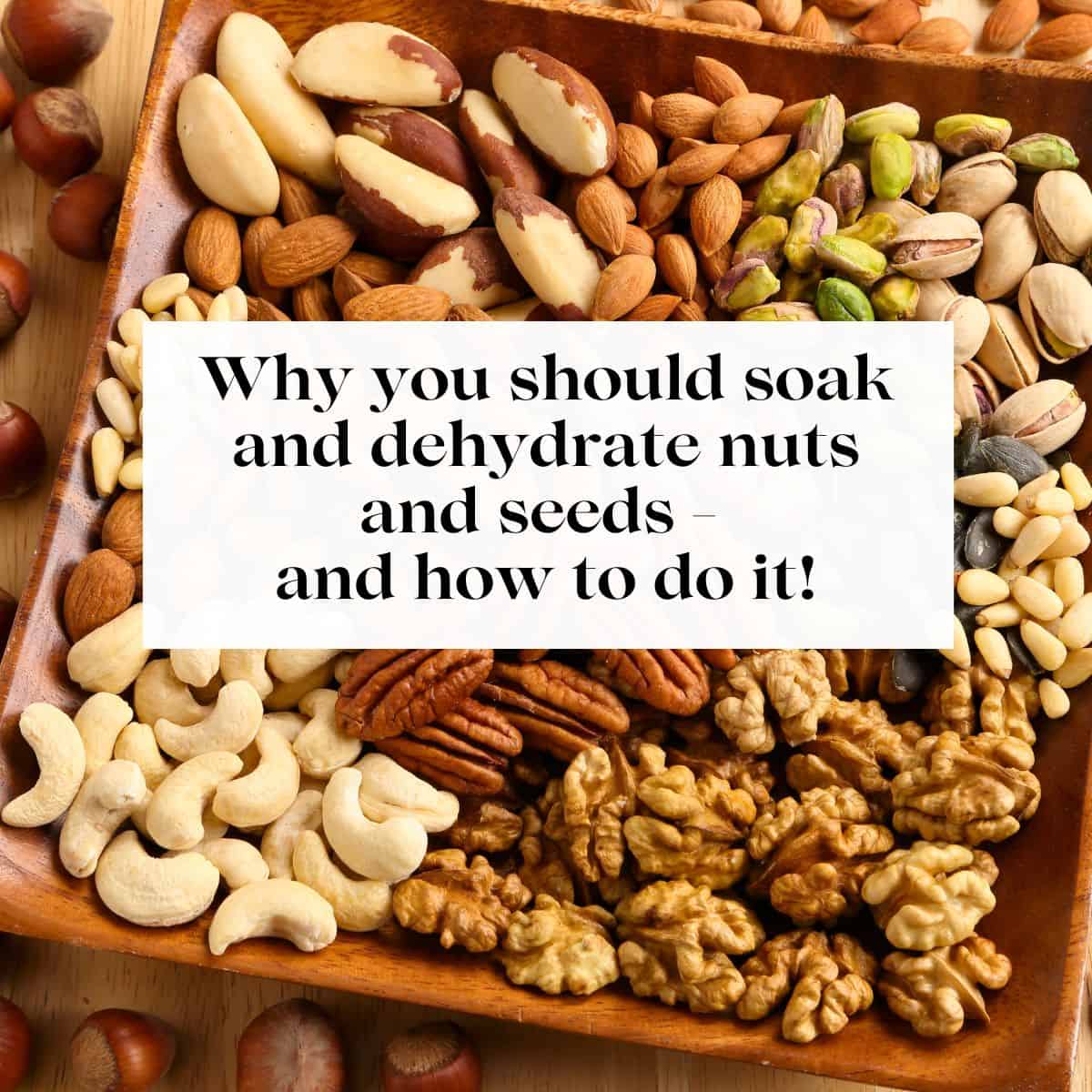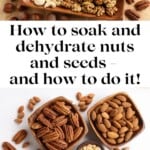Do you know why you should soak and dehydrate your nuts and seeds before you eat them? In this post I explain why you should soak and dehydrate your nuts and seeds (and how to do it) to not only improve digestion, but also improve your absorption and utilization of vitamins and minerals.

Disclaimer: some of the links in this post are affiliate links, where I make a small commission if you purchase the product through that link. This does not cost you anything extra and helps me keep this website running.
Table of Contents
- Why you should soak and dehydrate nuts and seeds:
- What is phytic acid?
- What does phytic acid do?
- How to decrease the phytic acid levels in food
- Benefits of activating nuts and seeds
- How to Soak and Dehydrate Nuts and Seeds
- Tips for soaked and dehydrated nuts and seeds:
- Frequently asked questions:
- Other health information you will want to read:
- Our expertise:
Why you should soak and dehydrate nuts and seeds:
Do you soak and dehydrate your nuts and seeds before you eat them? If not, you really should be, and here's why: a little thing called phytic acid.
What is phytic acid?
Phytic acid is the main storage form of phosphorus in many plant tissues, especially the bran portion of grains and seeds. Phytic acid is present in beans, seeds, nuts, and grains—especially in the bran or outer hull portion. Seeds and bran are the highest sources of phytates.
In general, nuts contain levels of phytic acid equal to or sometimes even higher than those of grains. Phytates are also found in tubers, and trace amounts are found in certain fruits and vegetables including berries and green beans. Raw, unfermented cocoa beans and cocoa powder are also very high in phytates.
What does phytic acid do?
Phytic acid contains the mineral phosphorus tightly bound in a snowflake-like molecule. In humans, the phosphorus is not readily available because of this blockage by phytic acid. Humans are unable to metabolize phytic acid due to the lack of phytate degrading enzyme activity in our digestive tracts. In other words, even though phytic acid is a good source of phosphorus, as humans, we can't actually access and use this phosphorus.
In addition to blocking phosphorus availability, phytic acid also binds to other minerals including iron, calcium, magnesium, manganese and zinc, making them unavailable as well. Studies have shown that phytic acid inhibits the absorption of iron, zinc calcium, magnesium and manganese.
Phytic acid not reduces the availability of minerals in food, but it also inhibits enzymes that we need to digest our food, including pepsin, which is needed for the breakdown of protein, amylase, which is needed for the breakdown of starch into sugar and trypsin, needed for protein digestion in the small intestine.
The detrimental health effects of phytic acid have been known for many years. As early as 1949 experiments showed that consumption of high phytate cereal grains interfered with bone growth and interrupted vitamin D metabolism. High levels of phytic acid in the context of a diet low in calcium and vitamin D resulted in rickets and a severe lack of bone formation. It has also been shown that excessive phytic acid consumption decreases vitamin D stores.
How to decrease the phytic acid levels in food
Phytase is the enzyme that neutralizes phytic acid and liberates the phosphorus. This enzyme co-exists in plant foods that contain phytic acid. Unfortunately, most humans do not produce enough phytase to safely consume large amounts of high phytate foods on a regular basis. However, many types of probiotic bacteria can produce phytase and help break down phytic acid. Fermented foods high in probiotics have also been shown to help degrade phytic acid. Thus eating a diet high in fermented foods and beneficial probiotic bacteria should help you break down phytic acid.
Additionally, you can decrease the phytic acid level in grains by soaking and dehydrating them. Evidence has shown that soaking grains and seeds for several hours, dehydrating them at very low temperatures, and then roasting or cooking them eliminates a large portion of phytates. Sprouting also activates phytase, thus reducing phytic acid even more.
There had been previous claims that soaking and dehydrating nuts also makes them easier to digest, but more recent studies refute this claim. As well, whether activating nuts actually increases nutrient bioavailability is controversial, with a recent study showing that soaking nuts did not improve the phytic acid to mineral ratios.
Benefits of activating nuts and seeds
The process of soaking and dehydrating nuts and seeds is referred to as "activating" nuts and seeds. As we discussed in the previous section, whether this process of activation actually makes the minerals in nuts and seeds more bioavailable is controversial, with more recent evidence showing that it might not have as helpful an effect as previously thought. This controversy has been termed the "soaking nuts myth."
Whether soaking and dehydrating nuts and seeds makes them easier to digest is also controversial. I personally find activated nuts easier to digest, but there haven't been many studies analyzing this effect so most of the evidence is anecdotal.
One clear benefit of soaking and dehydrating nuts and seeds, or activating them, is the taste. Nuts that have been activated taste better than raw nuts. Activating nuts gives them a nice crisp texture and a slightly sweeter flavour compared to raw nuts.
Now that we have reviewed the pros and cons of activating nuts and seeds, let's review how to actually do it.
How to Soak and Dehydrate Nuts and Seeds
In order to properly soak and dehydrate your nuts and seeds you will need a dehydrator. I personally use and love this Excalibur one. It was such a good investment and I have not had any problems with it.
Now let's review how to activate various types of nuts and seeds:
Pumpkin seeds (pepitas)
Soak 4 cups of raw pumpkin seeds in warm water with 1 tablespoon of sea salt for 7 hours or longer (up to 24 hours). Then drain and rinse the seeds. If desired, sprinkle the seeds with seasonings such as salt before placing them in your dehydrator. Then dehydrate them at 105-150 degrees Fahrenheit for 12-24 hours, turning the seeds occasionally, until they dry and crisp.
Sunflower Seeds
Soak 4 cups of raw sunflower seeds in warm water with 1 tablespoon of sea salt for 7 hours. Rinse the seeds and then dehydrate them at 105-150 degrees Fahrenheit for 12-24 hours, turning occasionally, until they are nice and crisp.
Pecans and Walnuts
Soak 4 cups of raw pecans or walnuts in warm, water with 1 tablespoon of sea salt for 7 hours or longer (up to 24 hours). Rinse the nuts and place in your dehydrator and dehydrate them at 105-150 degrees Fahrenheit for 12-24 hours, turning occasionally, until they are dry and crisp.
Pecans can be stored in an airtight container, but walnuts are more susceptible to become rancid so should always be stores in the refrigerator.
Pine Nuts and Hazelnuts (Skinless)
Soak 4 cups of raw pine nuts or hazelnuts nuts in warm water with 1 tablespoon of sea salt for at least 7 hours, or overnight. Rinse the nuts and then place them in your dehydrator and dehydrate at 105-150 degrees Fahrenheit for 12-24 hours, until dry and crisp.
Almonds
Soak 4 cups of raw almonds in warm water with 1 tablespoon of sea salt for 7 hours or longer (up to 24 hours). Rinse the nuts, then place them in your dehydrator, sprinkle with salt/honey/other spices if desired, and dehydrate then at 105-150 Fahrenheit for 12-24 hours, turning occasionally, until they are dry and crisp.
Note that this method will also work for silvered almonds.
Cashews
Soak 4 cups of raw cashews in warm water with 1 tablespoon of sea salt for no more than 6 hours (I prefer 4 hours). Rinse the nuts and place them on a baking sheet lined with parchment paper, sprinkle with salt and bake them at 200-250 degrees Fahrenheit for 12-24 hours, turning occasionally, until they are crisp.
Note: Some care must be taken in preparing cashews. They will become slimy and develop a gross taste if allowed to soak too long or dry out too slowly, which is why the oven method is preferred for activating cashews.
Macadamia Nuts
Soak 4 cups of raw macadamia nuts in warm water with 1 tablespoon of sea salt for at least 7 hours, or overnight. Then dehydrate the nuts at 105-150 degrees Fahrenheit for 12-24 hours, until dry and crisp.
Tips for soaked and dehydrated nuts and seeds:
- I recommend using filtered water if you can for the best results.
- Don't forget to add the salt when you soak the nuts.
- Use sea salt rather than table salt.
Frequently asked questions:
For most nuts you will need a dehydrator to properly dry them after they have been soaked as most ovens don't have a temperature setting that is low enough. However, cashews can be soaked and dried in an oven as they tolerate a higher temperature.
Yes I would definitely recommend it. If you just soak nuts without dehydrating them they taste really gross and are very mushy and unappealing to eat.
Most air fryers do not have a low enough temperature setting to properly dehydrate nuts and seeds.
You can store soaked and dehydrated nuts in an airtight container at room temperature for a few weeks. If you want them to last longer, store them in the fridge or freezer.
Other health information you will want to read:
- Health benefits of gelatin
- What is the paleo diet?
- Is there mercury in your mascara?
- How to choose non-toxic cookware
Our expertise:
Dr. Erin Carter, MD, FRCPC, is a physician with board certifications in internal medicine and rheumatology. She is passionate about preventative healthcare including nutrition, environmental health and low toxicity living. She is also a self-trained chef and has been creating and publishing healthy recipes since 2015. Her recipes have been featured on many different websites and online publications.


Jen
Should the skins of almonds be peeled after soaking, or left on?
Erin Carter
You can do either! I usually leave them on but if you prefer skinless almonds you could also remove them.
Eileen Hartman
If I want to grind cashews or sunflower seeds for flour, can they be raw or should they be soaked and dehydrated first? I'm thing that almond meal is probably raw nuts??
Thanks.
Kristin Baker
Are walnuts that don't claim to be raw already soaked and dehydrated? I currently buy Kirkland's organic walnuts off Amazon.
Also, do you need to soak and dehydrate nuts if you are putting the nuts (walnuts) into oatmeal before pressure cooking the batch? Wondering if cooking them will help decrease the phytates, so I can skip soaking and dehydrating them before adding them to my oatmeal.
Erin Carter
Hey Kristin!
So no, unless a brand specifies that their nuts are soaked and dehydrated, or "sprouted" they are not. It is possible to find nuts that have been sprouted and can be bought this way but they always cost more. And as far as I know pressure cooking doesn't help. The heat is too high. It also skips the soaking process which is needed.
Hope that helps!
Marius
Is the sole purpose of dehydrating the nuts to make them last longer before going rancid? And how long does walnuts last in the fridge after dehydration?`
Erin Carter
Nope! As the article explains dehydrating the nuts helps improve their nutritional value and makes them easier to digest.
Lynne
Why do we need to add sea salt to the water for soaking nuts and seeds?
Erin Carter
It helps neutralize the enzymes